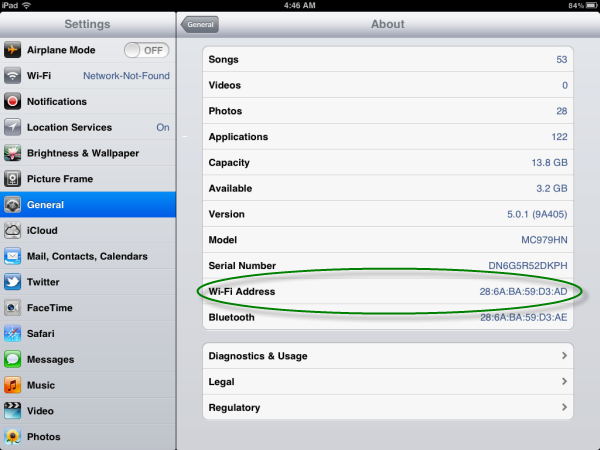

- #FIND MY MAC ADDRESS FOR MY PHONE HOW TO#
- #FIND MY MAC ADDRESS FOR MY PHONE UPDATE#
- #FIND MY MAC ADDRESS FOR MY PHONE SOFTWARE#
- #FIND MY MAC ADDRESS FOR MY PHONE PC#
Add your device’s MAC address to the MAC filtering table of the Wi-Fi router. Channel: Try using another channel, preferably 11 or lower. MAC filter: Make sure it’s turned off. You could also try setting a static IP address if you have problems accessing the internet using your Wi-Fi connection. To wake up a device, Wake-on-LAN (WOL) technology uses a specific network package containing the MAC address of the destination network card.  SSID and password: Make sure there are no special characters or characters which are not in the standard ASCII character set. Network mode/speed: Change to auto or mixed mode instead of b, g or n.
SSID and password: Make sure there are no special characters or characters which are not in the standard ASCII character set. Network mode/speed: Change to auto or mixed mode instead of b, g or n. #FIND MY MAC ADDRESS FOR MY PHONE HOW TO#
If you are not sure how to change the settings, check the user guide of the router or contact your router manufacturer.
Check the following router settings using a computer. #FIND MY MAC ADDRESS FOR MY PHONE UPDATE#
Contact the router manufacturer for instructions on how to update the router software.
#FIND MY MAC ADDRESS FOR MY PHONE SOFTWARE#
Make sure that the router is using the latest software version. If the signal is low, or there is no signal, move closer to the Wi-Fi hotspot, that is, your device that provides the Wi-Fi network. Check the Wi-Fi signal strength (Wi-Fi icon) in the status bar. Verify that you are in range of the Wi-Fi router. Make your device forget the settings for the Wi-Fi network to which you want to connect, and then reset it. Click Details and the Physical Address is your MAC Address. Right-click your Local Area Connection or Wi-Fi Connection (depending on how you are connected) and select Status. #FIND MY MAC ADDRESS FOR MY PHONE PC#
Standard Operating Systems It’s rare that you would need a MAC Address to connect a laptop or PC to a network, but instructions are provided here just in case.
Look for the Wi-Fi CERTIFIED logo or phrase on the product packaging or in the product literature, or search the Wi-Fi CERTIFIED products database on the Wi-Fi Alliance website. Type ncpa.cpl into the search box and press ENTER. MAC address: If you need to add your Alexa device to your router's list of approved devices, scroll down on this screen until you see the MAC address. This means that 2 24 (= 16.777.216) unique OUAs can be assigned per OUI. Bit 25-48 (network adapter identifier): Bits 25 to 48 provide device manufacturers with 24 bits for assigning a unique hardware identifier (organizationally unique address, OUA). A corresponding service is available, for example, on. The assignment of OUIs is usually public and can be determined via databases. Bit 3–24 (manufacturer identification): Bits 3 to 24 encode an identifier (organizationally unique identifier, OUI), which is assigned exclusively to hardware manufacturers by IEEE. Addresses that are only locally unique are called locally administered address (LAA) and are marked with U/L = 1. 
If U/L = 0, the address is valid worldwide as a universally administered address (UAA).
Bit 2 (registry): The second bit of the MAC address indicates whether it is an address with global validity (universal) or whether the address has been assigned locally (local). Multicast addresses are identified by I/G = 1 and are addressed to several receivers. If I/G = 0, it is a unicast address for a single network adapter. Tap on Device You should now see your MAC Address, labeled Wi-Fi MAC. This bit is called I/G (short for individual/group). Once you locate your MAC address, add your devices within your My Account. Bit 1 (receiver): The first bit of the MAC address specifies whether it is an individual or group address. The bit sequence of each MAC address is divided into 4 areas, each of which encodes different information.







 0 kommentar(er)
0 kommentar(er)
